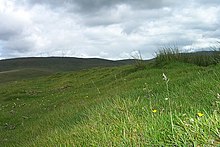 A section of the Deil's Dyke on Dalhanna Hill at New Cumnock | |
 | |
| NS 8000 0591 to NS 8404 0526 | |
| Location | New Cumnock to Durisdeer parish |
|---|---|
| Designer | Unknown |
| Type | Earthwork |
| Material | Earth, stones and turf |
| Length | Up to 16 mi (26 km) |
| Width | 3 m (9.8 ft) |
| Height | 0.7 m (2 ft 4 in) |
| Completion date | Medieval or Iron Age |
Deil's Dyke, Pict's Dyke or Celt's Dyke[1][2] in south-west lowland Scotland is a linear earthwork that roughly follows the contours that divide upland pasture from lowland arable land, effectively acting like the head-dykes of medieval and later times although its true purpose has not been settled. The Deil's Dyke, sometimes written as 'dike', is formed from an earthen berm of rounded form that varies from 2.0 to 4.0 m (6.6 to 13.1 ft) wide and a maximum of 0.7 m (2.3 ft) high, sometimes having a stone core. Where a fosse accompanies the bank it is usually an inconsequential 0.5 m (1.6 ft) or so in width on average and around 0.4 m (1.3 ft) deep, more often located on the uphill or outfield side. As a defensive structure the dyke has no obvious military value and its erratic route militates against it being a practical political boundary.[3]
- ^ "Scotland's Places". Retrieved 16 January 2018.
- ^ Cite error: The named reference
RCAHMSqwas invoked but never defined (see the help page). - ^ Historic Environment Scotland. "Deil's Dyke (101258)". Canmore. Retrieved 16 January 2018.